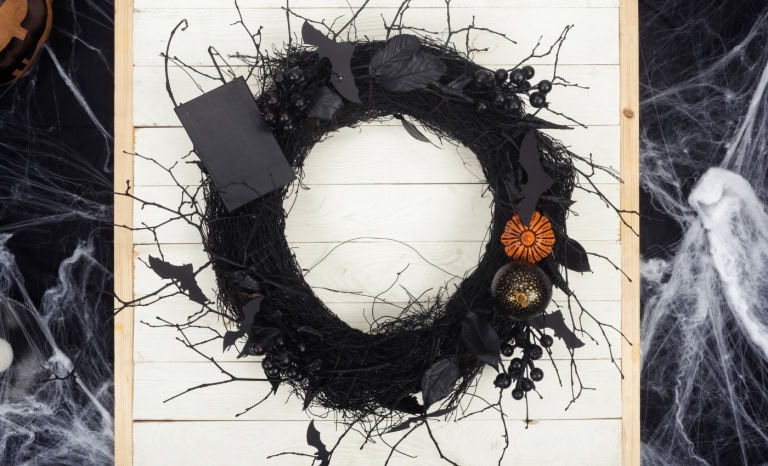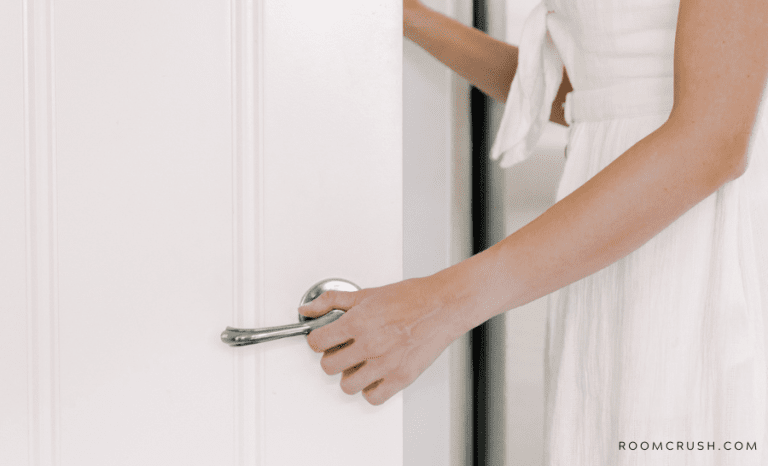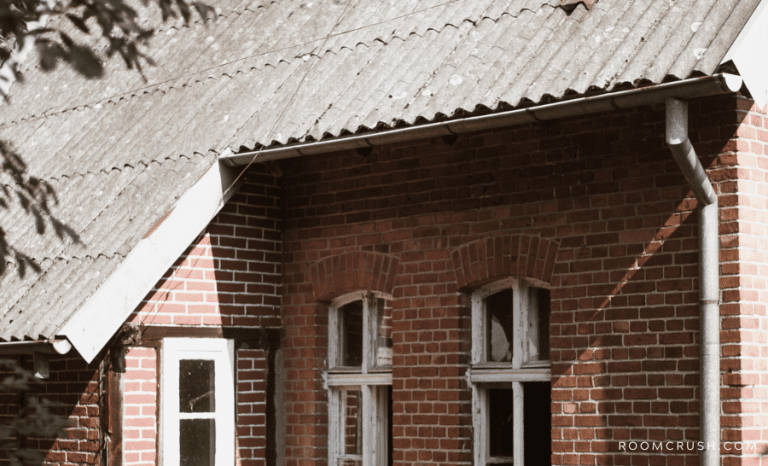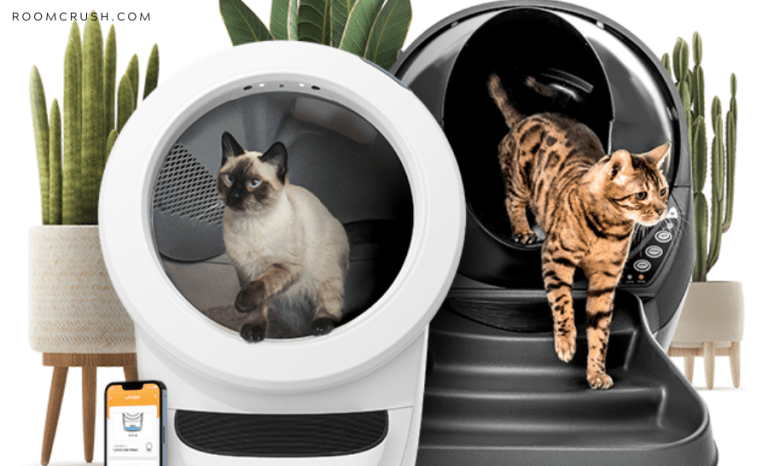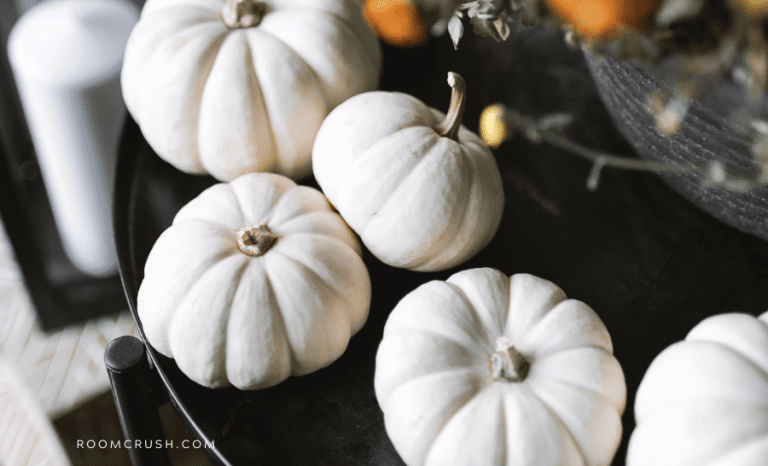Hydrogen Peroxide Hacks You Wished You Knew Sooner

We have some excellent hydrogen peroxide hacks to share with you today that will make your life easier.
These hacks will allow you to use fewer harmful chemicals in your home. You’re going to love these ideas.
However, there are some good reminders we want to keep in mind when using hydrogen peroxide to keep everyone safe.
This site uses ads and affiliate content as an Amazon associate earning on qualifying purchases. Disclosure.
[toc]
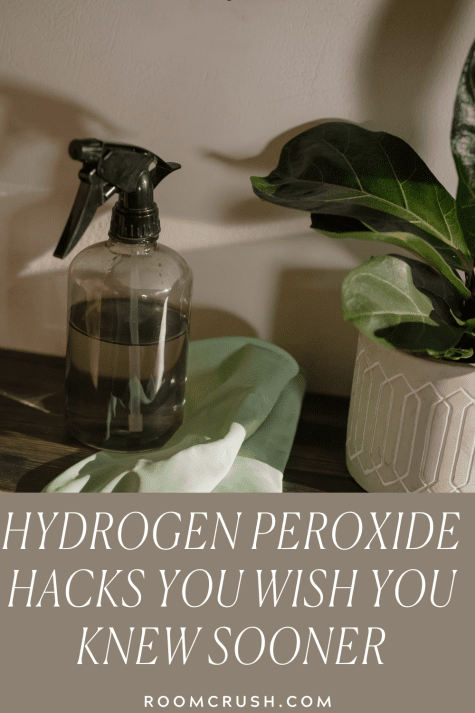
Let’s get to that all-important question:
What Should You Not Put Hydrogen Peroxide On?
You should not put hydrogen peroxide on colored fabrics and natural fibers without testing a small area first.
You also should not put hydrogen peroxide on marble and granite continually.
Why?
If you’re using hydrogen peroxide to disinfect your marble or granite countertops, you want to use it with caution.
Using a bit is ok, but using it continually can actually cause the finish to slowly break down. With continual use, it could also cause some discoloration.
Since hydrogen peroxide is considered an oxygen bleach, A.K.A non-chlorine bleach, it can potentially cause some discoloration in fabrics.
Test, test, test before you directly apply hydrogen peroxide on your clothes/towels/sheets.
DO NOT, I repeat, DO NOT mix hydrogen peroxide with vinegar. The combination creates peracetic acid, which can be super harmful to you.
A few notes to consider in regard to your body:
- You should never ingest hydrogen peroxide
- Never use it as a lightening agent for your hair or skin (without talking to a doctor first, if you so choose)
- Never use it in your eyes, or use higher concentrated peroxide without protecting your hands.
- If you do choose a higher concentration, use gloves to prevent any irritation.
Ok, so I avoid everything I should, but do I need to rinse off hydrogen peroxide when I use it? Great question.

Do You Need to Rinse Off Hydrogen Peroxide?
In short, yes and no. If there is any potential of ingesting the peroxide somehow, someway, or you are dealing with mold and mildew, you would want to rinse items thoroughly after you use hydrogen peroxide.
If you are simply cleaning your toilets or mirrors in the bathroom, cleaning and disinfecting doorknobs, toys, floors, and the like, you do not need to rinse after using hydrogen peroxide.
For example, when it involves some items in the kitchen, like disinfecting dirty sponges, cleaning off fruits and vegetables, cleaning a cutting board, and more.
Or using peroxide to disinfect your toothbrush or retainers, you would want to rinse off the hydrogen peroxide.
In regard to laundry, use your normal wash cycle to rinse the peroxide off the fabrics. Do not let fabrics sit in hydrogen peroxide for hours or days before rinsing or washing.
Leaving peroxide on for an extended period of time can cause discoloration or weakening of the fabric fiber’s strength.
Unbeknownst to me, there are loads of hydrogen peroxide hacks to use in day-to-day life!
I would honestly let that same bottle of hydrogen peroxide sit in the bathroom cabinet for months (even years!) and only take it out when I had a cut or scrape and wanted to give it a good cleaning.
Let’s take a stroll around the house and find some hacks for that brown bottle tucked away in the back of your bathroom cabinet.
Hydrogen Peroxide Hacks For The Kitchen
Wash Fruits and Vegetables
Fresh produce isn’t always as fresh and clean as we think.
With frequent pesticide use nowadays, lots of handling by multiple people on the way to the market or store, and the chance of bacteria on our fruits and veggies, thorough washing before eating is always a good idea.
There are many options out there, but an easy and non-toxic way of cleaning off all those germs is a 50/50 mix of water and hydrogen peroxide.
You can soak, or spray, your produce down with the mixture, let it sit for a few minutes, and then rinse with clean water.

Sanitize Cutting Boards
Plastic and wooden cutting boards come into contact with a multitude of food, and germs for that matter.
To keep cutting boards clean and kill off any bacteria that can accrue, pour your 3% hydrogen peroxide directly on the board.
Let it sit, and watch it fizz and sanitize!
You can use a clean sponge to scrub the hydrogen peroxide all-around your cutting board and then rinse completely.
I like these sponges as their heavy-duty materials help them last longer:
- NINE SCRUBBING SPONGES: This pack of Scotch-Brite Heavy Duty Scrub Sponges includes nine sponges
- 3X SCRUBBING POWER*: Tackle tough messes with these heavy duty sponges that provide 3X more scrubbing power compared to other leading sponges
- LASTS 3X LONGER*: Made from durable material, each dish sponge lasts 3X longer than the leading national value brand
- PERFECT FOR TOUGH JOBS: They’re great for cleaning uncoated pots and pans, grates, oven racks, outdoor grills, and more, making these dish sponges kitchen essentials
- FLEXIBLE, DURABLE, STRONG: These dish sponges for dishes are S-shaped for a comfortable grip while getting into corners easily
Disinfect Kitchen Sponges
Speaking of using a sponge, these little absorbent babies can get dirty and grimy pretty fast! Using them to clean dirty dishes, our countertops, our stoves, and our sinks regularly, causes them to also harbor lots of bacteria.
Using equal parts hydrogen peroxide to water in a large bowl, immerse your sponges into the mixture and allow them to sit for a few minutes.
You’ll see lots of fizzing.
Be sure both sides of your sponge get immersed in the solution. Rinse under clean water. Finally! Odorless and disinfected sponges are ready to use.
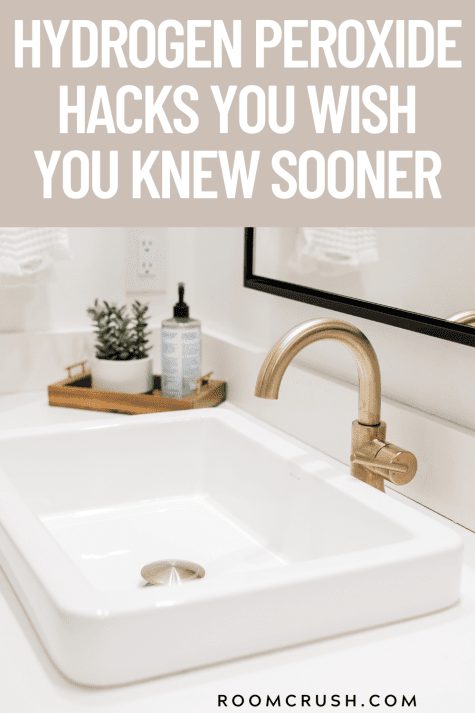
Clean your Refrigerator
You’ve been there. I’ve been there. Goodness gracious, we’ve all been there!
We’ve left our food in the fridge a little too long and now those leftovers are starting to smell, the cilantro is wilted and stuck to the produce drawer, and we’ve waited too long to clean that sticky bottle of BBQ sauce which has now made a lovely ring on the bottom of our door organizers.
Are we doomed? No way!
Clean out your fridge as you normally would and use a spray bottle to spray hydrogen peroxide directly to your shelves, drawers, and refrigerator walls.
Related: Best Eco-Friendly Cleaning Products for a Non-Toxic Home
Let it sit for a few minutes to kill any of the bacteria inside and knock out those smelly odors. Wipe down with some water to rinse and let dry. You’ll feel like you’ve never had such a clean fridge!
I love using a chemical-resistant spray bottle for this purpose:
- Chemical-resistant detailing product bottle
- This bottle comes with a heavy duty, high output sprayer head
- Pumps out 1.3 ml of product per stroke; 40% more than standard sprayers. Product Form: Clear Plastic
- 16 oz. bottle capacity for professional detailing in any situation
- Printed labels for easy product dilution, hazard identification, and precaution statements
Hydrogen Peroxide Hacks For Cleaning The Bathroom
Whiten Grout and Get Rid of Soap Scum
The longer we go without cleaning our grout regularly as we should, it seems to turn from a bright white to another far less desirable color, very quickly I might add. Soap scum can also accumulate pretty quickly at the bottom of our showers, tubs, or sinks. Solution?
To whiten grout and clean soap scum in a non-toxic way, and without the strong chemical smell that makes you dizzy almost immediately, make a paste with about 2 parts baking soda and one part hydrogen peroxide.
- Versatile, effective and affordable solution for over 170 years
- Use for baking, cleaning, deodorizing and more.Baking Soda can be used with HE washing machines. Add 1 cup with your liquid laundry detergent
- Free of harsh chemicals and gentle enough to use on many surfaces
- Hundreds of uses like: fresh box for baking
If it’s too thick, add a little more hydrogen peroxide. You don’t want it watery, but you also don’t want it clumpy.
Apply the paste on the grout, sinks, and floors of your shower and tub, and scrub well with a firm bristled brush. Let sit for at least five minutes and wipe off the paste with a wet rag.
Clean Mold and Mildew
Due to hydrogen peroxide’s antifungal properties, it is a great choice when trying to kill off the spores of any mold and clean away mildew.
As I mentioned earlier, peroxide is an oxygen bleach, so it is a nice alternative to the strong chlorine bleach out there.
However, this also means it does take a little longer to work, so patience is key here!
Spray hydrogen peroxide considerably onto the mold and mildew and let sit for around 10 minutes or so, once the fizzing stops.
Then use a firm bristled brush or rag to deep clean the area and scrub away. Bye-bye fungi!
For areas where you don’t want to use hydrogen peroxide, you can use a natural cleaner like Force of Nature. This cleaner is kid-and-pet friendly, kills mold, and is safe to use on many surfaces.
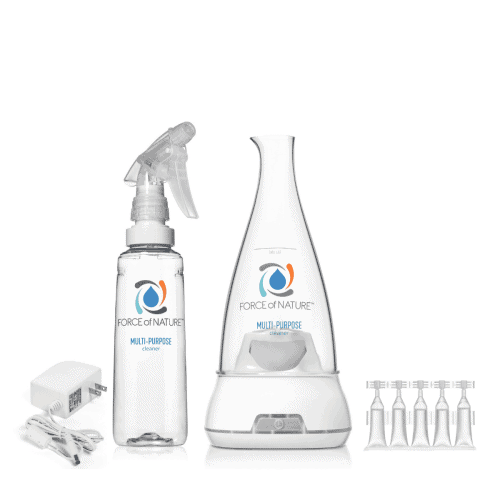
Streak-free, Shiny Mirrors
Like you would spray a glass cleaner, spray hydrogen peroxide directly on your mirrors or glass you want to spiff up, and use a lint-free cloth to buff.
Beautiful streak-free mirrors in minutes, without too much elbow work!
How To Use Hydrogen Peroxide In Your Laundry

Remove Tough Stains and Blood Stains
Whether it’s berry stains, grass stains, blood stains, etc., apply a paste of baking soda and hydrogen peroxide then scrub with a brush to lift the stain.
A toothbrush is helpful here. Also, allow the mixture to sit for a few minutes then wash as normal.
This has been my lifesaver!
Be sure to check your laundry before you put them in the dryer to make sure the stains are removed. This is because the heat from the laundry dryer can cause them to set, and once that happens, it’s extremely difficult to get them out.
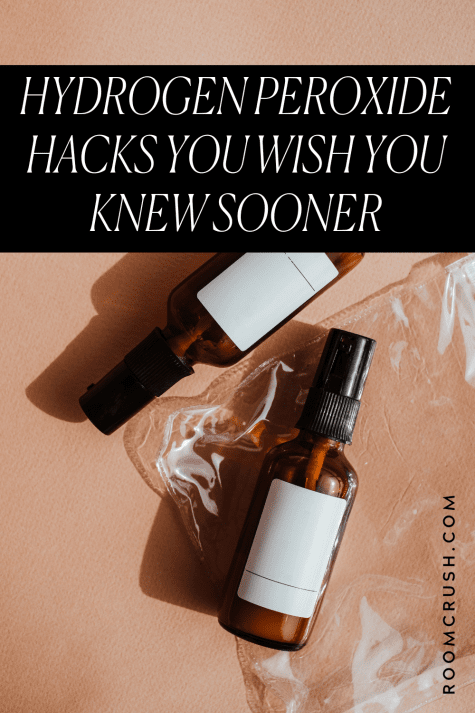
If the stain remains, use some more hydrogen peroxide and baking soda paste and scrub, scrub, scrub. Remember to rewash or at least rinse.
Although this can help to get some stains out after they have been left for a while, immediate action after a stain is always best and most effective!
By the way, we were on the hunt for Best Smelling Laundry Detergent Combos and tested a bunch of combinations.
NOTE: As mentioned above, before you test this method on any white and colored fabrics, do a test area to make sure it does not cause any discoloration before you use hydrogen peroxide on any large stains.
Do You Need To Rinse Off Hydrogen Peroxide?

Hydrogen Peroxide Hacks You Wished You Knew Sooner – Conclusion
The uses for Hydrogen Peroxide are truly endless! It’s a non-toxic, effective cleaner that is easily accessible- and, might I add, super affordable!
You’ll feel safe using it around the loved ones in your home and confident that it’s giving you the clean environment you so love.
So, go ahead and take out that bottle from the bathroom and start using it.
Explore more of these hacks around the home by using them in the garden and with everyday household items. Try out the hacks mentioned above and see how you like them.
Once you start, you’ll never be able to stop.
Read this next:
- Best Eco-Friendly Cleaning Products For A Non-Toxic Home
- Mind-Blowing Oven Cleaning Hacks You Have To Try
- Bathroom Cleaning Hacks You Have To Try





